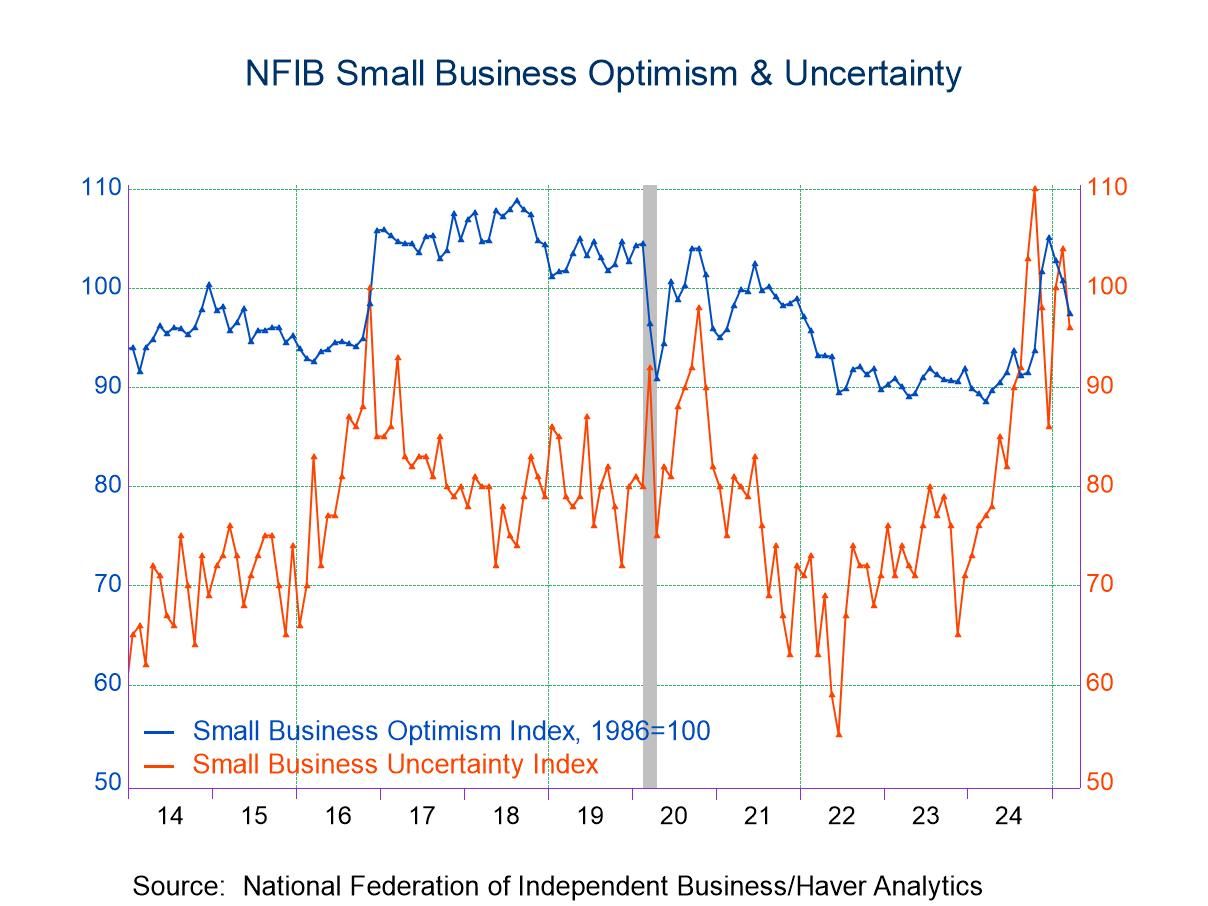- Both energy & food prices decline.
- Price gain in core goods remains firm.
- Services prices decline.
Introducing
Tom Moeller
in:Our Authors
Prior to joining Haver Analytics in 2000, Mr. Moeller worked as the Economist at Chancellor Capital Management from 1985 to 1999. There, he developed comprehensive economic forecasts and interpreted economic data for equity and fixed income portfolio managers. Also at Chancellor, Mr. Moeller worked as an equity analyst and was responsible for researching and rating companies in the economically sensitive automobile and housing industries for investment in Chancellor’s equity portfolio. Prior to joining Chancellor, Mr. Moeller was an Economist at Citibank from 1979 to 1984. He also analyzed pricing behavior in the metals industry for the Council on Wage and Price Stability in Washington, D.C. In 1999, Mr. Moeller received the award for most accurate forecast from the Forecasters' Club of New York. From 1990 to 1992 he was President of the New York Association for Business Economists. Mr. Moeller earned an M.B.A. in Finance from Fordham University, where he graduated in 1987. He holds a Bachelor of Arts in Economics from George Washington University.

Publications by Tom Moeller
by:Tom Moeller
|in:Economy in Brief
- USA| Apr 11 2025
U.S. Housing Affordability Improves Slightly in February
- Home prices rise but mortgage rates decline.
- Median income improves.
- Affordability is mixed across the country.
by:Tom Moeller
|in:Economy in Brief
- Federal receipt growth slows.
- Outlay growth surges.
by:Tom Moeller
|in:Economy in Brief
The Consumer Price Index edged 0.1% lower in March after rising 0.2% in February and 0.5% in January. A 0.1% rise had been expected in the Action Economics Forecast Survey. The y/y increase in the headline CPI fell to 2.4% from 2.8% in February. It was the weakest y/y gain in six months and was below the 9.1% peak in June 2022. The CPI excluding food & energy rose 0.1% following increases of 0.2% in February and 0.4% in January. A 0.3% rise had been expected. The 2.8% y/y gain is the weakest in core prices in four years and below the 6.6% peak in September 2022.
Energy prices declined 2.4% (-3.3% y/y) last month after a 0.2% February rise. Gasoline prices declined 6.3% (-9.8% y/y) after falling 1.0%. Fuel oil prices weakened 4.2% (-7.6% y/y) after rising 0.8% in February. Natural gas prices jumped 3.6% (9.4% y/y) following a 2.5% gain, and electricity prices gained 0.9% (2.8% y/y) after rising 1.0% in February.
Food prices rose 0.4% (3.0% y/y) in March after a 0.2% February increase as egg prices strengthened 5.9% (60.4% y/y) following a 10.4% gain. Meat, poultry & fish prices rose 0.6% (3.1% y/y), after a 0.5% rise, while dairy product prices rebounded 1.0% (2.2% y/y) and reversed February’s 1.0% decline. Cereal & bakery product costs eased 0.1% (+1.1% y/y) after February’s 0.4% rise while fruit & vegetable prices dropped 0.5% (-0.7% y/y), the same as in both of the prior two months. Nonalcoholic beverage prices rose 0.6% (2.4% y/y) in March after falling 0.5% in February.
Goods prices less food and energy eased 0.1% both m/m and y/y in March after rising 0.2% in February. Prices of used cars and trucks fell 0.7% (+0.6% y/y) last month after rising 0.9% in February while new vehicle costs improved 0.1% (0.0% y/y) after slipping 0.1% in February. Apparel prices increased 0.4% (0.3% y/y) following a 0.6% gain while appliance prices eased 0.1% (-2.5% y/y) following a 0.5% increase. Home furnishings prices held steady (-0.3% y/y) after rising 0.2% in February. Recreation product costs fell 0.3% (-2.3% y/y) in March after falling 0.7%. Education & communication product costs rose 0.5% last month (-5.7% y/y) after falling 0.2% in February.
Services prices less energy improved 0.1% (3.7% y/y) last month following a 0.3% March gain. Shelter prices rose 0.2% (4.0% y/y) last month after a 0.3% rise as owners equivalent rent of primary residences increased 0.4% (4.4% y/y) after four consecutive 0.3% increases. The cost of lodging away from home fell 3.5% (-2.5% y/y) after improving 0.2% in February. Rents of primary residences gained 0.3% (4.0% y/y) for the fourth consecutive month. Transportation service prices fell 1.4% (+3.1% y/y) after falling 0.8% in February reflecting a 0.8% decline (+7.5% y/y) in the cost of motor vehicle insurance. Public transportation costs declined 4.2% (-3.5% y/y) after falling 3.4% in February. Prices of medical services increased 0.5% (3.0% y/y) after rising 0.3% and the cost of recreation services edged 0.1% higher (4.3% y/y) after increasing 0.8 in February.
The Consumer Price figures can be found in Haver's USECON database. The expectations figure is contained in the AS1REPNA database.
by:Tom Moeller
|in:Economy in Brief
- Inventories trend higher y/y.
- Sales surge broadly.
- Inventory-to-sales ratio continues to decline.
by:Tom Moeller
|in:Economy in Brief
- USA| Apr 09 2025
Mortgage Applications Surge as Rates Fall in Latest Week
- Refinanced loans nearly double; purchase loan applications are strong as well.
- Fixed-rate mortgages decline.
- Average loan size surges.
by:Tom Moeller
|in:Economy in Brief
- Economic & sales expectations weaken.
- Employment plans fall but job openings rise.
- Prices decline but price expectations rise.
by:Tom Moeller
|in:Economy in Brief
- USA| Apr 08 2025
U.S. Energy Prices Are Mixed in Latest Week
- Gasoline prices strengthen.
- Crude oil prices fall.
- Natural gas costs rise.
by:Tom Moeller
|in:Economy in Brief
- USA| Apr 07 2025
U.S. Consumer Credit Slips in February
- Nonrevolving credit declines slightly.
- Revolving credit edges up.
by:Tom Moeller
|in:Economy in Brief
- USA| Apr 04 2025
U.S. Payroll Growth Improves in March, but Downward Revisions & Higher Jobless Rate Cloud Employment Picture
- Job strength is concentrated in three sectors.
- Earnings growth trend decelerates.
- Jobless rate is highest in four months.
by:Tom Moeller
|in:Economy in Brief
- USA| Apr 03 2025
U.S. Trade Deficit Narrows Slightly from Record in February
- Goods deficit shrinks while services surplus falls.
- Exports are double January’s increase; imports are roughly steady.
- Energy product imports decline while crude oil prices stabilize.
by:Tom Moeller
|in:Economy in Brief
- USA| Apr 02 2025
U.S. ADP Payroll Gain Rebounds in March; Pay Growth Eases
- Employment increase is strong in both services & factory sectors.
- Wage growth for “job stayers” and “job changers” moderates.
- Small business employment recovers; hiring at medium-sized firms slows.
by:Tom Moeller
|in:Economy in Brief
- of1062Go to 1 page













